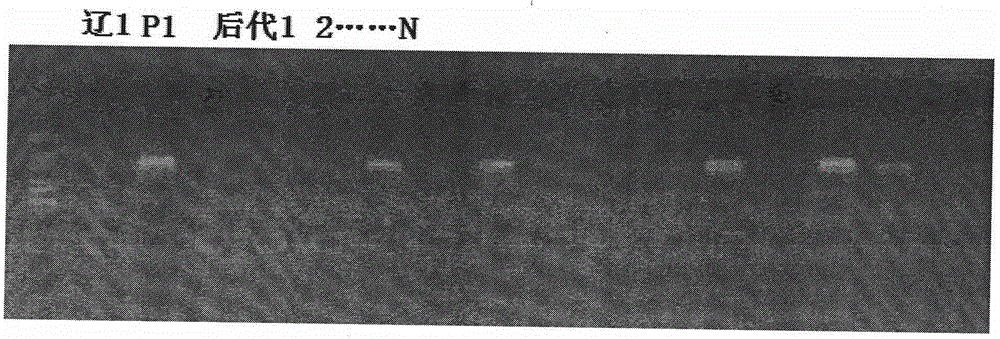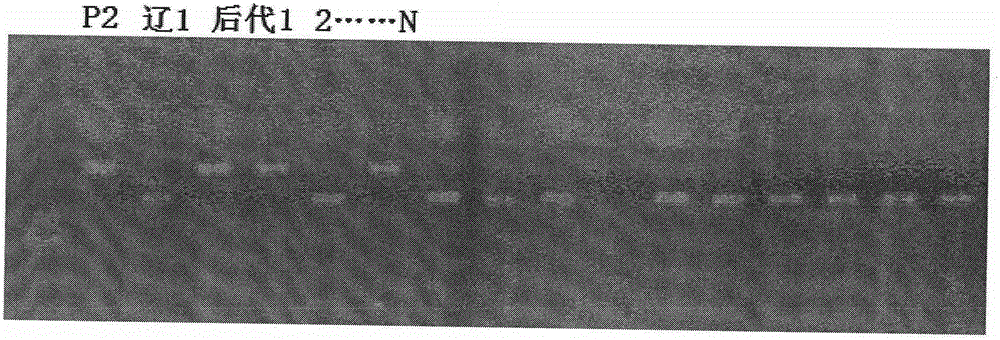Multi-gene high rice blast resistance material breeding method adopting marker assisted selection
A molecular marker-assisted, rice blast resistance gene technology, applied in plant genetic improvement, botanical equipment and methods, applications, etc., can solve problems such as heavy workload, difficult identification, blindness, etc., and achieve the effect of improving efficiency
- Summary
- Abstract
- Description
- Claims
- Application Information
AI Technical Summary
Problems solved by technology
Method used
Image
Examples
Embodiment 1
[0026] Example 1: Identification and screening of the offspring population constructed by crossing the resistant parent P1 containing the rice blast resistance gene Pita and the susceptible parent Liaoxing No. 1
[0027] The resistant parent P1 containing the rice blast resistance gene Pita was crossed with the susceptible parent Liaoxing 1, and then selfed, and then the selfed F2 generation was screened for traits and rice blast resistance gene Pita, and the plant height, growth period, 50 F2 single plants, which are similar to Liaoxing 1 in high yield and contain the disease resistance gene Pita; then backcrossed with the susceptible parent Liaoxing 1 for the first time, and self-crossed to obtain BC 1 f 2 , and then screened for traits and disease-resistant gene Pita, and selected BC with excellent traits and disease-resistant gene Pita 1 f 2 50 plants per plant; then carry out a second backcross with the susceptible parent Liaoxing 1, and self-cross to obtain BC 2 f 2,...
Embodiment 2
[0028] Example 2: Identification and screening of resistant parent P2 containing rice blast resistance gene Pi5 crossed with susceptible parent Liaoxing No. 1 to construct a resistant and susceptible population
[0029] The resistant parent P2 containing the rice blast resistance gene Pi5 was crossed with the susceptible parent Liaoxing 1, and then selfed, and then the selfed F2 generation was screened for traits and rice blast resistance gene Pi5, and the plant height, growth period, 50 F2 single plants, which are similar in yield and yield to Liaoxing 1 and contain the disease resistance gene Pi5; then backcrossed with the susceptible parent Liaoxing 1 for the first time, and self-crossed to obtain BC 1 f 2 , and then screened for traits and disease-resistant gene Pita, and selected BC with excellent traits and disease-resistant gene Pi5 1 f 2 50 plants per plant; then carry out a second backcross with the susceptible parent Liaoxing 1, and self-cross to obtain BC 2 f 2 ...
Embodiment 3
[0030] Example 3: Gene aggregation of the offspring BC2F4 strain containing the rice blast resistance gene Pita and the offspring BC2F4 strain containing the rice blast resistance gene Pi5
[0031] Use the BC2F4 generation of Pita individual plants containing the disease resistance gene to cross with the disease resistance gene pi5 individual plants, self-cross to obtain F2, and use molecular markers A1, A2, A3, A4, B1, B2 to screen for disease resistance genes Pita, pi5 , and combined with the identification of disease resistance in the field, select a single plant that contains two disease resistance genes and performs well in the field for selfing plus generation. A new disease-resistant variety containing Pita and pi5 disease-resistant genes with pure and stable performance in the field was obtained by self-crossing and adding three generations.
PUM
| Property | Measurement | Unit |
|---|---|---|
| Diameter | aaaaa | aaaaa |
Abstract
Description
Claims
Application Information
 Login to View More
Login to View More - Generate Ideas
- Intellectual Property
- Life Sciences
- Materials
- Tech Scout
- Unparalleled Data Quality
- Higher Quality Content
- 60% Fewer Hallucinations
Browse by: Latest US Patents, China's latest patents, Technical Efficacy Thesaurus, Application Domain, Technology Topic, Popular Technical Reports.
© 2025 PatSnap. All rights reserved.Legal|Privacy policy|Modern Slavery Act Transparency Statement|Sitemap|About US| Contact US: help@patsnap.com



